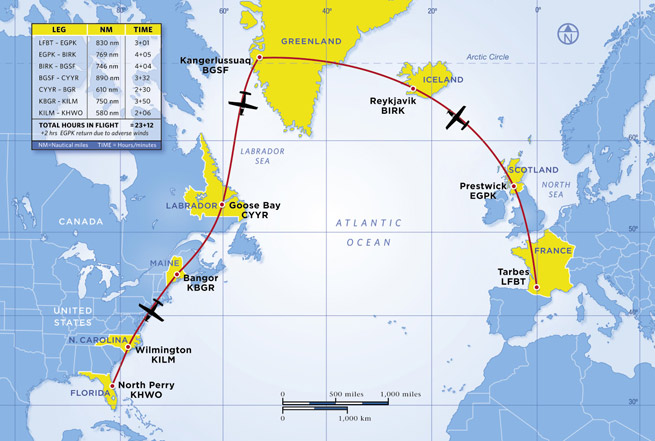
The northern route across the Atlantic, originally called the Blue Spruce Route, dates back to the late 1930s, and is the closest path to a great circle route for ships and airplanes making a crossing. The advantage: shorter distances from North America to Europe and back. The downside: low ceilings, icing conditions, and howling westerly winds in the colder months of the year.
You’re standing on a ramp somewhere in the United States and spot a TBM taxiing in. You note the aggressive lines; the snarl of the PT6 engine as the pilot cycles it in and out of its beta range; and, like many, appreciate its inspired design. For most, it’s the ultimate expression of the ideal personal single-engine turboprop; that’s why more than 700 have been sold during the TBM line’s 24 years of production. But how did that airplane get here, you wonder. You know the factory is in Tarbes, France, and that’s where our story begins.
Jacques took the left seat for this leg because surface winds at Reykjavik were forecast to be 230 degrees at 13 gusting to 24 knots for the ILS to Runway 19, which would mean more wind shear and turbulence on final.
Ratsu came once again, but the headwinds had indeed died down—fluctuating around 96 knots. Even so, the TBM 900 has the right combination of speed and fuel burn to allow it to fly at a 75-percent torque setting with a comparatively low 50-gph fuel flow that produced a true airspeed of 295 knots and an average groundspeed of 199 knots or so. In the end, we landed at Reykjavik with 85 gallons to spare. The landing and handling fees at Reykjavik? They were 250 euros, or about $344.
Next up was the somewhat shorter, 746-nm leg from BIRK to Kangerlussuaq (BGSF) in Greenland. Once again, headwinds were an issue, with 132 knots on the leg from BIRK to the Gimli Intersection. Even so, at 75-percent torque and a fuel flow of 50 gph, we saw a 293-knot true airspeed and a 169-knot groundspeed. By the time we got to Pevak Intersection over Greenland, the winds had backed off in our favor—as forecast—with a mere 46 knots on the nose. Groundspeed leapt to 259 knots, FOD jumped to 81 gallons, and life was good. After four hours, four minutes in the air, we landed in severe clear conditions at Kangerlussuaq (once known as Sondrestrom Air Force Base).
The leg from BGSF to Goose Bay was a 890-nm grind in comparatively light (42 knots) headwinds until reaching Prawn Intersection off the Canadian coast, where they went to a high of 78 knots. Up to Prawn, we were comfortable enough with the lighter headwinds to push the power up to 94 percent torque, which gave us a 60-gph fuel flow, a 313 knot true airspeed, and a 277 knot groundspeed. Now this was more like TBM 900 flying! After Prawn, however, power was pulled back to favor fuel reserves, resulting in FOD predictions of 91 gallons—a very comfortable reserve, given that we were nearing the destination.
The second instrument approach of the day came at Goose Bay, where it was night and snow was falling. Visibility dropped to four in snow, so it was the localizer back course approach to Runway 8. The four of us were glad to be there, after the day’s 11 hours, 40 minutes of flying. Because snow was forecast to fall nonstop through the next day, 900AZ and 900PL were put in a heated hangar overnight.
That night, we checked into the Hotel North—well-known to any ferry pilot who’s flown through Goose Bay—and had a quick dinner at the Mariner’s Galley right next door. Good thing, because we had no car and the snow was ankle-deep.
Day four: Goose Bay to North Perry.
There’s about 1,875 nm and 8.5 hours of flying to do today. And, of course, there will be headwinds. By this time headwinds have become a kind of running joke among the two crews. “70 knots? 90 knots? Not a problem. Once you’ve seen 160 knots, you can handle anything,” was the gist of the comments.
The first leg, to the Bangor (Maine) International Airport (BGR), was a 610-nm hop to clear U.S. Customs and Immigration inbound. It began with departing Goose in one-half-mile visibility in snow and vertical visibilities of 400 feet. But once up at our customary FL280, we bumped the power up to 323 knots and plowed through “light” headwinds hovering around 52 knots. Soon, we were on approach to Bangor in very gusty and turbulent, but good VFR, conditions.
The next leg, to Wilmington (North Carolina) International Airport (ILM), was uneventful except for the initial 142-knot headwind components in the New York City area. For a time the FOD reading was a concerning 45 gallons, but then the winds slackened, the fuel reserves went up, and the fuel worries went away. An ILS approach to Wilmington’s Runway 6, through three miles visibility in rain, ended the last of the long legs.
The two-hour, 15-minute leg to North Perry was a breeze. Sure, we had to circumnavigate some thunderstorms over Florida’s east coast, but time flashed by and soon we were in the clear night sky over Fort Lauderdale, looking for the airport among the forest of lights below. And there they were—the approach lights to North Perry’s Runway 19R. A couple minutes later and the airplanes were parked at the Daher-Socata hangar.
We made it. There’s always a sense of great accomplishment after an ocean crossing, and this time was no different. We’d come 5,100 miles, flown 28 hours in three days, logged five instrument approaches and departures in fairly rotten weather—and met the delivery deadline. We never, at any time, had a tailwind! Whenever you look back on it, or look at a globe or planning chart, such a trip looks daunting. And yet, for the small subculture of ferry pilots, it’s routine business. For me, it’s an object of wonder as well. The sights—the emptiness, glaciers, volcanos, icecaps, icebergs, fjords, forests, and the ever-present angry seas—are as incomparable as they are inspiring. Not to mention the weather.
My TBM 900 time had come to an end, for now. I can’t wait for the next crossing. Maybe I’ll even get a tailwind.
Email [email protected]
Video Extra: Fly along for a front row seat on the crossing.
In March, Daher-Socata—manufacturer of the TBM—invited AOPA Pilot along for a one-of-a-kind, epic ferry flight. It involved bringing a flight of four brand-new TBM 900s to the United States, the largest number of TBMs ever imported at one time. (Typically, one TBM per week is ferried across the North Atlantic.) These were serial numbers 1000, 1001, 1002, and 1003—the first four TBM 900s to reach American shores.
Like every ferry/delivery flight, the schedule was hectic, transpired at a breakneck speed, and brought its own special challenges. But yours truly was up to it. I’d done 10 TBM Atlantic crossings over the years, and wouldn’t miss this one for anything.
Day one: arrival at Tarbes
The odyssey began March 12 with an Air France flight to Paris, and a connecting flight that brought us on March 13 to the Pau-Pyrenéés Airport in Pau, France. (Trivia item: the Wright brothers established a flying school at Pau in 1908 while touring Europe.) A cab ride brought us to the Daher-Socata factory at the Tarbes-Lourdes Airport, and we hit the ground running. Accompanying me was AOPA Live’s executive producer, Warren Morningstar, who documented the trip on video for broadcast on AOPA’s weekly webcast, AOPA Live This Week.
Morningstar unpacked his gear and began shooting the factory assembly lines and ramp environment. I took still photographs and met up with the other pilots.
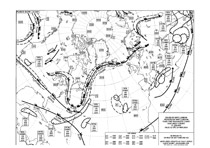
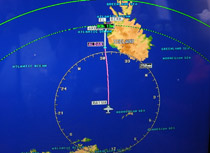
The high-altitude significant weather chart for the day we first attempted to fly from Prestwick, Scotland, to Reykjavik, Iceland (top). A shot of N900AZ’s multifunction display (above) shows the situation at Ratsu intersection.
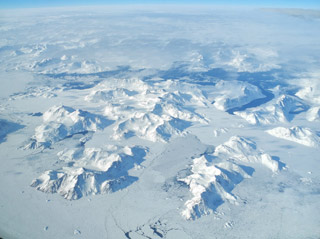
A view of Greenland’s ice cap.
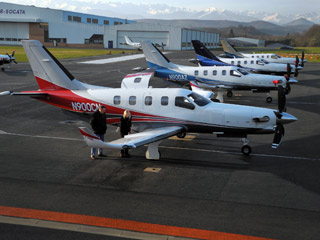
The four TBM 900s prepare to leave the Daher-Socata factory at the Tarbes-Lourdes-Pyrenéés Airport.
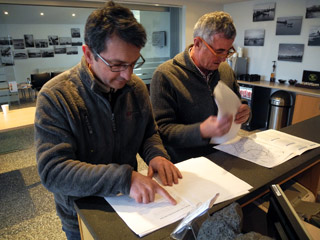
Daher-Socata pilots Stéphane Jacques (left) and Giles Bellot check the weather prior to taking off from Reykjavik, Iceland, bound for Kangerlussuaq, Greenland.
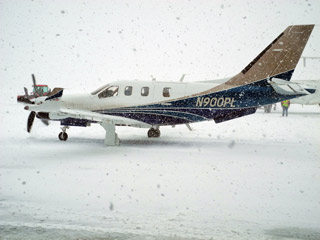
A snowy departure from Goose Bay, Labrador.
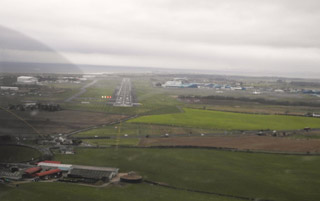
On approach to the windy Prestwick, Scotland, airport.
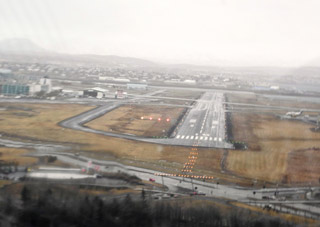
An equally gusty arrival at Reykjavik.
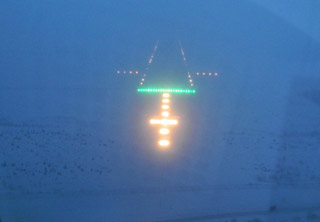
A short final on a snowy back course approach to Goose Bay’s Runway 8 (above).
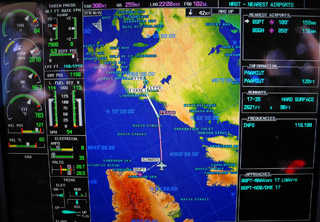
The G1000’s MFD view of the routing for the long, 894-nm leg from Kangerlussuaq to Goose Bay.
On the ramp were the four airplanes, bound for an already scheduled, highly publicized, highly produced event at Orlando, Florida’s Fantasy of Flight Museum, designed to reveal the new TBM 900s to customers, prospects, and VIPs. That “reveal” was taking place on March 18. The idea was to get the planes to Daher-Socata’s North American facility at Hollywood, Florida’s North Perry Airport (HWO) on March 16.
The heat was on. We’d have to get the TBM 900s to North Perry in two days. The planes were gassed up, pre-flown for the trip, and found to be squawk-free.
Here are the airplanes, along with their pilots and passengers:
SN 1000: N900AZ, with company chief of flight ops Stéphane Jacques and me.
SN 1001: N900CN, with veteran ferry pilot Margrit Waltz and new owner Ross Matthews.
SN 1002: N900PL, with company flight test pilot Gilles Bellot and Morningstar.
SN 1003: N900KN, with company flight test pilot Jacques Raissiguier and Rich Clark, pilot for new owner Larry Glazer, president of the TBM Owners and Operators Association.
Day two: Tarbes to Prestwick, Prestwick to Prestwick
After a briefing, the first to leave on March 14 were Waltz and Matthews, followed by Raissiguier and Glazer. “My” airplane left next, followed shortly by N900PL. The destination for the day was Reykjavik, Iceland, but first we’d make an intermediate stop for fuel and survival equipment at the Prestwick, Scotland, airport. Via airways, the flight plan to Prestwick was 830 nautical miles and would take two hours, 57 minutes based on the projected winds aloft at our cruise altitude of FL280.
With just 28 knots’ worth of headwind, Jacques flew the first leg at max cruise power. Translated, that meant 98-percent torque and a 64-gph fuel burn for a 324-knot true airspeed and a 296-knot groundspeed. Not bad. The 900 was performing well, with a 20-minute time to climb to FL280 doing 160 KIAS. Mind you, the TBM 900 is capable of cruising at 330 knots true airspeed. But fly at lower than optimal altitudes, or fight headwinds, and you’ll have to back off on the power if you want to conserve fuel—as we shall see.
All was well until approaching the MID (Midhurst) VOR over England. Thickening low clouds signaled a well-advertised cold front’s arrival, and conditions only worsened for the arrival at Prestwick. Mainly it was a wind issue; visibility was seven miles and the ceiling was 7,000 overcast. Prestwick was using the ILS to Runway 30, but the winds were varying between 12 and 30 knots, and the wind direction was switching around, too, from 230 to 200 degrees. Yep, pretty much a direct crosswind. On the ILS, the wind readout on AZ’s Garmin G1000 was showing 60 knots at 3,000 feet, so we knew to expect windshear and turbulence. And so it was. Jacques fought a mighty sink rate and crosswinds on final, but the landing was exceptional given the conditions. They say the TBM 900’s max demonstrated crosswind component is 20 knots, but I think we beat that by a wide margin that day. By the way, we landed with 110 gallons of fuel in reserve—shown as FOD (fuel over destination) on the G1000’s MFD—enough for another 1.5 hours of flying. Ideal margins for an Atlantic crossing this far north.
Then it was gas up, look at the flight plan and weather for the route to Reykjavik (BIRK), grab our survival suits and rafts, and launch once more. The survival suits were of the “Gumby” style, all floppy and loose-fitting. We pulled them on up to our waists so we’d be able to quickly don the top part if necessary, then shuffled into the cockpit, Gumby arms trailing behind us.
The news was bad in the winds aloft department. After leaving Prestwick, we’d run into 90-knot headwinds at FL280 during the first third of the trip, then they’d go up to 130 knots. That’s about the limit for a crossing, Jacques said. Any more headwind and we’d have too little in fuel reserves for the landing in Iceland—or none at all, if the winds were stronger than forecast.
And they were. I flew the Prestwick-to-Reykjavik leg and felt the same turbulence and shear that Jacques did on his approach. The turbulence persisted until we broke out on top at FL200 or so, and then the headwinds picked up. First 100 knots on the nose, then 110, 120, 130, and 140 knots. By the time we reached Ratsu intersection northwest of Ireland, we had 155 knots of headwind. The G1000 said we’d have just 37 gallons of fuel reserves for the landing at Reykjavik. The range rings on the G1000’s MFD map page showed we’d have 45 minutes worth of FOD. Then the range ring moved closer to our position, and closer still, meaning we’d have less than 45 minutes of fuel—assuming the winds stayed the same.
We tried to find a slightly lower power setting that would give us an equal FOD value for a lesser fuel burn—but no dice. A descent to FL260 proved that the winds were equally strong. In fact, we were flying in a jet stream’s core of strongest winds. They’d only slack off if we went to even lower altitudes, where higher fuel burns would eat up our fuel reserve minimums in short order indeed.
What to do? The only prudent thing: turn around, go back to Prestwick, and land for the night. On the way back, of course, groundspeeds hit 425 knots, and we made it back in 45 minutes, landing with 103 gallons to spare. For the landing, the crosswinds had slackened a bit, to 17 knots, but the visibility was 10 in drizzle with a 2,000-foot ceiling. Once more, it was an ILS to Runway 30 for both airplanes, a tiedown and fuel-up in what was now steady rain, and a night at the Fairfield House in town. We’d flown three hours, 50 minutes attempting to get to Reykjavik, but only made it to Ratsu Intersection and back.
Day three: Prestwick to Goose Bay
This would turn out to be our marathon day. The headwinds for the 769-nm Prestwick-Reykjavik route were forecast to slack off to the 90- to 120-knot level, which meant we stood a good chance of arriving at Reykjavik with decent fuel reserves. We were so inured by the previous day’s 160-knot headwinds that double-digit winds actually left us feeling somewhat comfortable.



